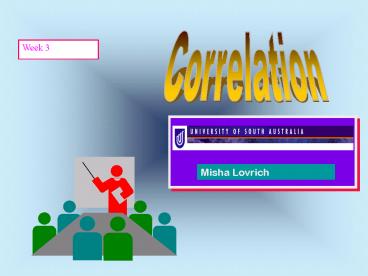Statistics and Computing 101 PowerPoint PPT Presentation
1 / 20
Title: Statistics and Computing 101
1
Correlation
Week 3
2
OBJECTIVES
- 1. TO DISCUSS THE DIFFERENCE BETWEEN CORRELATION
AND REGRESSION ANALYSIS - 2. TO DRAW SCATTER DIAGRAMS.
- 3. TO OBTAIN AND DISCUSS PEARSONS
- CORRELATION COEFFICIENT.
3
1. Examining Relationships
- We often see things that are related to one
another.
- Time spent studying / Examination Mark
- Age and Blood Pressure
- Mothers weight and her babys birthweight
- Smoking and lungs cancer
- Tablet Weight and Tablet Potency
- Tablet Weight and Dissolution
4
Examining Relationships
- Independent variable (also known as an
- explanatory or X variable) which is a
variable - that attempts to explain the variation in Y.
- Dependent variable (also known as a response or
Y variable) which measures the outcome of a study.
5
Correlation and Regression
- The most common procedures for examining
relationships between quantitative variables
- Correlation Analysis
Is there a relationship between two (ore more)
variables, and if there is, what is the strength
of the relationship.
- Regression Analysis
- Explore the nature of the relationship
- Develop a model that relates Y to X
- Predict the future values of Y variable
6
Correlation and Regression
- Note Carefully
- Neither regression nor correlation can be
interpreted as establishing cause-effect
relationships.
Correlation is probably the most abused concept
in statistics.
7
2. Scatterplot (Scatter Diagram)
Archaeopteryx the classic example of a
transitional form, in this case between reptiles
and birds, a so-called "missing link", according
to Charles Darwin who published his book on
evolutionary theory in 1859. Still today,
Archaeopteryx is a key text-book example of
evolutionary theory, and a landmark fossil for
palaeontologists and evolutionary biologists..
8
Choice of variables
- In correlation the choice of which variable to
call X and which to call Y is arbitrary. - However in regression labelling is important
9
Scatter Diagram (1)
10
Scatter Diagram (2)
- What can we conclude by inspecting a scatter
diagram?
1) Is there a relationship? 2) Shape of the
relationship 3) Strength of the relationship 4)
Direction of the relationship
11
Scatter Diagram (3)
No Relationship
12
Scatter Diagram (4)
Perfect, Direct, Linear
Perfect, Inverse, Linear
13
3.0 Pearsons Correlation Coefficient
- The most widely used method of measuring
correlation is the - Pearsons Correlation Coefficient r
14
Pearson Correlation Coefficient
- r is a measure of strength of the linear
relationship between the paired X and Y values in
a sample - it is a unitless (dimensionless) measure
- ranges from -1 to 1
15
Pearson Correlation Coefficient
Perfect Inverse Correlation
Perfect Direct Correlation
No Linear Correlation
-1
1
0
-0.7
0.7
Strong Negative
Strong Positive
16
Correlation - Calculation
Let us calculate the correlation coefficient for
our example 1 data. First traditionally
Formula
17
Correlation - Minitab (1)
18
Correlation - Minitab (2)
MTB gt Correlations (Pearson) Correlation of
Femur and Humerus 0.994 MTB gt
19
Lecture Exercises
- Each of the following statements contains a
blunder. Explain what is wrong. - 1. There is a high correlation between the
gender of Aust workers and their income. - 2. We found a high correlation (r1.09) between
students rating of faculty teaching and ratings
made by other faculty members. - 3. The correlation between planning rate and
yield of corn was found to be r0.23 bushel.
20
Last year exam question
If the correlation between two measures is 1.20,
we can conclude (a) The value of one measure
increases by 1.20 when the other increases by
1. (b) 1.20 of the observations fall on the
regression line. (c) 20 of the observations fall
on the regression line. (d) 20 of the
variation in one measure is accounted for by the
other. e) None of the above

